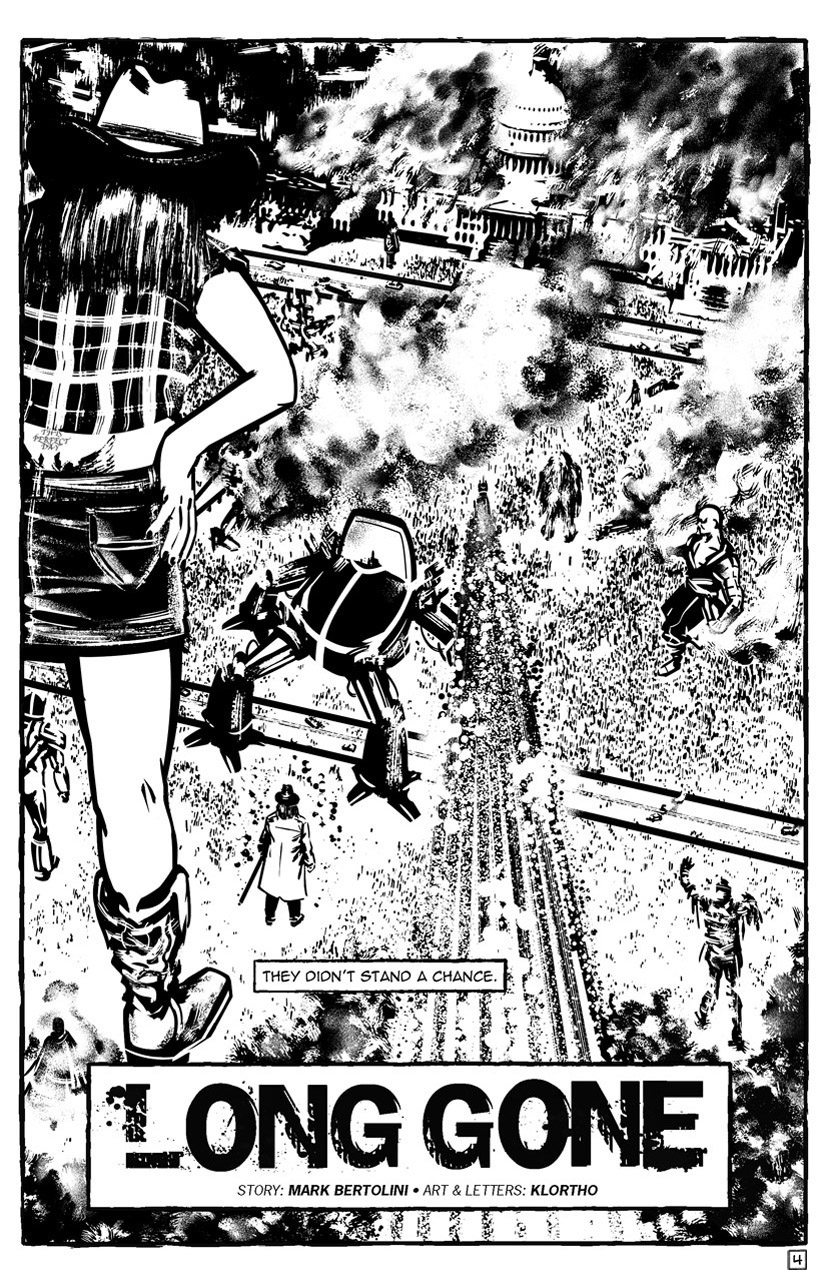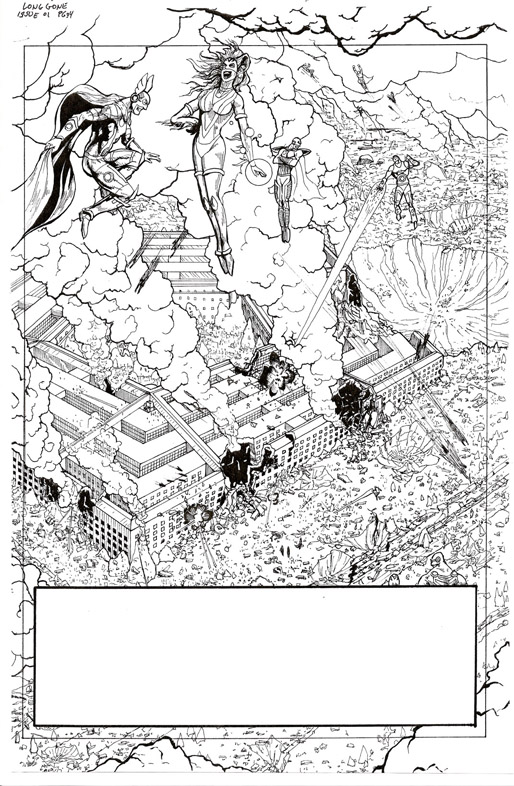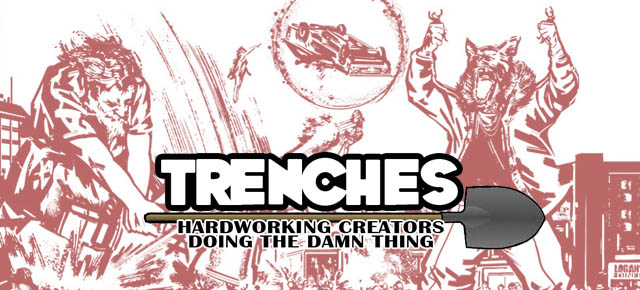TRENCHES #1: The Long Gone Story
So, you want to write comic books, do ya? You want to get that grand idea of yours out to the masses, pair it with some fantastic artwork, and take the industry by storm? Then get in line. It’s not as easy as it might sound. But with perseverance, talent, and some luck, it can be possible. At least it became so for me.
Finding an Artist
 As an aspiring comic book writer with plenty of ideas but a distinct lack of artistic ability, I was in the same position as most writers: I needed an artist. I had a great script (as far as I was concerned), one that I thought had a pretty good mainstream bent to it, but without artwork, all I had were 22 pieces of paper.
As an aspiring comic book writer with plenty of ideas but a distinct lack of artistic ability, I was in the same position as most writers: I needed an artist. I had a great script (as far as I was concerned), one that I thought had a pretty good mainstream bent to it, but without artwork, all I had were 22 pieces of paper.
So I hit up the websites that I knew of, looking for an artist. I placed Want Ads at Digital Webbing.com, at Penciljack.com, and waited.
And waited.
And waited.
I quickly realized part of the problem: I had no money to pay an artist. Just a fact of life, all of the money I had was earmarked for things like food, car, mortgage. You know, the important, real-world stuff. I got such a lackluster response to my want ads that I decided a change of tack was necessary. I started watching the artists who were posting sequential pages, guys who were already doing the work, and I waited to find someone who I thought could bring my story to life.
The Story
The story, Long Gone, was about an old man who survived the superhuman apocalypse. It has been described as The Terminator but with superhumans instead of robots, or The Walking Dead with superhumans in place of the zombies. The idea came to me very vividly one day. I was driving on the highway at one of those weird times of day when there were no other cars with me. I drove for a 2 or 3 minute stretch where I was the only car on the road, and right away, my writer’s brain starting putting together a story. Where were all the other cars? All the other people? What happened to them? The answer came to me later on: the superhumans wiped them all out. This story clicked in my head, and right away I knew the beginning, middle, and end.
The Artist, Round One
Thus armed with my story and my script, I searched for the right artist. I had a specific idea in mind of how the story would look. I’m a big fan of artists like Alex Maleev, Michael Lark, and Paul Azaceta, guys with heavy blacks and stylized artwork. And then I found my guy on Digital Webbing. I’m going to refrain from using his name, for reasons that will become clear, but I sent him a message, explained the story, and he agreed to do up an 8-page sample package.
And he came back with some really great, really moody artwork that nailed the scenes I had pictured in my head. It was real stark black and white with some nice ink washed gray tones. The artist even did the letters, which was a bonus, as that was one less piece of the puzzle I had to locate. Once the 8-page package was done, I was all set.
The Submission Package
But what to do with it? I’d previously submitted stuff to Image comics, and never got a response, which meant they’d passed on it. I didn’t want to just dump this story into a slush pile somewhere, where no one would ever look at it. So I started researching some smaller companies, the small press guys with good reputations. I quizzed my fellow creators, ran things past people I trusted, and put together a nice list of potential publishers. First on that list was Markosia Entertainment, a small press outfit based in the UK who had done some very nice work on some book I actually owned. I thought it was worth a shot, so I dropped a general inquiry email and waited. I didn’t wait long, though, as I got a response from none other than the publisher himself, Mr. Harry Markos, who said if I had something for him, to send it over. So over it was sent, and again, I waited, and again, not for long. The response to the package was great, Harry liked the art and liked the story and was interested in moving forward with it.
Needless to say, this being my first time at the dance, I may have soiled myself, just a little. Harry and I set up a phone call, where we discussed the story and how it was different from the type of story that Markosia normally published, being a superhero story. Harry liked that it didn’t focus on the heroes, though, that it was about this solitary old man surviving in this horrific world. His actual words were I like that it takes the piss out of superheroes.
So, we were all set to go, right? Wrong. The contracts came for the artist and myself, and I ran mine past a trusted resource who said to go for it. My first time at bat, I wasn’t going to get much better than what Markosia was offering, and I’d already decided to sign what they sent. I kept the rights, they published the work, we split any profits. More than enough for me. But not enough for the artist. He had done the 8-page sample on spec, and once the contracts came out, wanted to earn a page rate. His figure? $100 per page.
I ran this past Harry, who actually laughed. I could get ex-Marvel or DC guys to do it for $60 a page, he said. Markosia, being a smaller company, doesn’t pay a page rate. Profits are made on the back-end. Yes, the dreaded back-end pay situation.
So, my artist decided to turn it down. I was in a panic. This was something I had written that I felt very strongly about, and it was looking like it was going to crash and burn right out of the gate. I talked to Harry about it, and asked if I could take some time to find a new artist, and he agreed, which made me feel pretty good about the story, as it was clear that it wasn’t just the art he had liked. Back to the well I went, this time armed with a more than before: a comic book that a publisher had already agreed to pick up. I hit up all of my creator friends, looking for the new right artist. I got a few bites, some really good artists, and sent some sample script pages to the people who had responded.
The Artist(s), Round Two
 And three days after sending the sample pages, I found my new guy. I received three pages in my email from an artist named Ted Pogorzelski, three pages that absolutely blew me away with the level of detail they incorporated. Three pages that I drooled over for hours. Three pages that landed Ted the gig. He was very enthusiastic, very excited about the prospect of getting his work published. I ran the pages past Harry, who approved them, but wanted them to be colored, as they were markedly different from the original black and white artwork. I had that covered, though. I’d worked with Aaron Viel on another project, where he had done the art and colors, and he agreed to color Long Gone. I had to find a letterer too, as the original artist did his own letters. The highly-esteemed ET Dollman agreed to come on-board as letterer and designer. The team was almost complete.
And three days after sending the sample pages, I found my new guy. I received three pages in my email from an artist named Ted Pogorzelski, three pages that absolutely blew me away with the level of detail they incorporated. Three pages that I drooled over for hours. Three pages that landed Ted the gig. He was very enthusiastic, very excited about the prospect of getting his work published. I ran the pages past Harry, who approved them, but wanted them to be colored, as they were markedly different from the original black and white artwork. I had that covered, though. I’d worked with Aaron Viel on another project, where he had done the art and colors, and he agreed to color Long Gone. I had to find a letterer too, as the original artist did his own letters. The highly-esteemed ET Dollman agreed to come on-board as letterer and designer. The team was almost complete.
It was decided that an editor was necessary, and I agreed. One had been recommended to me, and I spoke to Andrew Brinkley, who agreed to edit the series. I’d never worked closely with an editor before (I was convinced every word I wrote was pure gold), but his contribution would become invaluable, almost right away. When I had originally started writing Long Gone, I’d pictured it as a 96-page graphic novel. Harry had asked for it to be split up into four 22-page issues, which was fine, except that I’d already written more than thirty pages of script. Andrew’s first Herculean task was to wrangle the 30+ pages into a workable 22-page first issue. He chopped and tweaked and came out with an exceptionally strong first issue, with an excellent finishing page, one that made even me want to read the next issue.
So the five-man band was all set up. Moving from just me and one other person into a five-person team was hard to get accustomed to. That many people involved, that many moving parts, that many more emails, it was so much different than was I was used to. But we pushed on, and started getting the work done. I worked my fingers to the bone, writing those four scripts. With Andrew’s editing eye, I put together four scripts that felt very strong, very complete to me. When I typed the final line of dialogue for the fourth and final issue, I knew I had written something that was special. I was very proud of the scripts, it was easily the strongest writing I’d done to that point.
Part two of this column will give more details on the progression of Long Gone from idea to art to comic book, and the difference between it and another project of mine, one that skipped all the drama and got to the finish line a hell of a lot quicker than this first one.
***
Mark Bertolini is the writer of the supervillain series Breakneck from 215 Ink, the sci-fi/noir series Ghost Lines, available through Creator’s Edge Press, and the upcoming Markosia Entertainment mini-series Long Gone. He can be reached via email at Bertolini.mark@gmail.com
Related Posts:
Category: Trenches


















Great column, Mark. I like reading stories like this, about hard work and talent paying off. “Breakneck” is a great comic, and I’ll certainly be giving your other work a try based on that. Looking forward to reading the next instalment.